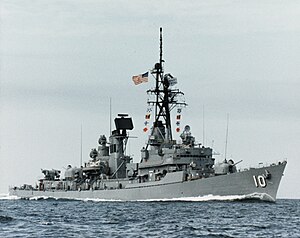 USS Sampson in late-1980s
| |
| Class overview | |
|---|---|
| Name | Charles F. Adams class |
| Builders | |
| Operators | |
| Preceded by | Farragut class |
| Succeeded by | Spruance class |
| Subclasses | |
| Built | 1958–1967 |
| In commission | 1960–2003 |
| Completed | 29 |
| Retired | 29 |
| Preserved | Mölders |
| General characteristics | |
| Type | Guided-missile destroyer (DDG) |
| Displacement |
|
| Length | 437 ft (133 m) |
| Beam | 47 ft (14 m) |
| Draft | 15 ft (4.6 m) |
| Propulsion |
|
| Speed | 33 knots (61 km/h; 38 mph) |
| Range | 4,500 nautical miles (8,300 km) at 20 knots (37 km/h) |
| Complement | 310–333 |
| Sensors and processing systems | |
| Armament |
|
The Charles F. Adams class is a ship class of 29 guided-missile destroyers (DDG) built between 1958 and 1967. Twenty-three were built for the United States Navy, three for the Royal Australian Navy, and three for the West German Bundesmarine. The design of these ships (known as project SCB 155)[5] was based on that of Forrest Sherman-class destroyers, but the Charles F. Adams class were the first class designed to serve as guided-missile destroyers.[Note 1] 19 feet (5.8 m) of length was added to the center of the design of the Forrest Sherman class to carry the ASROC launcher. The Charles F. Adams-class were the last steam turbine-powered destroyers built for the U.S. Navy. Starting with the succeeding Spruance-class, all U.S. Navy destroyers have been powered by gas turbines. Some of the U.S. Charles F. Adams class served during the blockade of Cuba in 1962 and during the Vietnam War; those of the Royal Australian Navy served during the Vietnam War and Gulf War.
- ^ a b c d e f Blackman, Raymond V. B. Jane's Fighting Ships (1970/71) p.437
- ^ Polmar, Norman "The U.S. Navy: Shipboard Radars" United States Naval Institute Proceedings December 1978 p.144
- ^ Polmar, Norman "The U.S. Navy: Shipboard Radars" United States Naval Institute Proceedings December 1978 p.145
- ^ Polmar, Norman "The U.S. Navy: Sonars, Part 1" United States Naval Institute Proceedings July 1981 p.119
- ^ Friedman, Norman (1982). U.S. Destroyers: An Illustrated Design History. Annapolis, Maryland: United States Naval Institute. pp. 299, 307–309. ISBN 0-87021-733-X.
Cite error: There are <ref group=Note> tags on this page, but the references will not show without a {{reflist|group=Note}} template (see the help page).